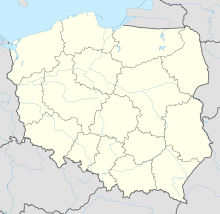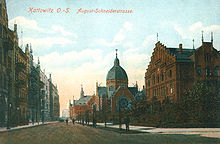Great Synagogue (Katowice)
Coordinates: 50 ° 15 ′ 40 ″ N , 19 ° 1 ′ 8 ″ E
The Great Synagogue in Katowice was built in 1900 and was one of the largest synagogues in Upper Silesia until it was destroyed in 1939 .
Building history and architecture
The monumental building on the corner plot of Tiele-Winckler-Platz / August-Schneider-Straße, at today's Mickiewicza Street, replaced the old synagogue from 1862, which was located at today's 3 Maja Street and with its 320 seats didn't have enough space for the city's ever-growing Jewish population. The Great Synagogue was built by the local construction company Ignatz Grünfeld, who had already built the Old Synagogue. Brick was chosen as the building material and natural stone for the facade structures . The new, splendidly furnished building cost around 500,000 marks and incorporated mainly elements of the Neo-Renaissance and Moorish styles , but also the Neo-Gothic , on the floor plan of a cross-shaped central building . Inside there was space for 1184 people. The synagogue, together with the mikveh and the parish hall, as well as the municipal grammar school built in the same year, formed an impressive architectural ensemble. Its huge dome was characteristic of the city skyline .
The synagogue only survived for almost four decades, until September 5, 1939. It was set on fire one day after the German invasion of Poland and then completely destroyed.
Today there is a market square called Plac Synagogi (Synagogue Square ) at this point . In July 1988 a memorial was erected there for the Jewish Katowice people who were murdered by the Germans in the Holocaust .
In May 2012, there were reports of plans to redesign the former location.
See also
Web links
literature
- Ewa Chojecka et al .: Sztuka Górnego Śląska od Średniowiecza do końca XX wieku. Muzeum Śląskie, Katowice 2004, ISBN 83-87455-77-6 .
Individual evidence
- ↑ Klaus-Dieter Alicke writes in the Lexicon of Jewish Congregations in German-speaking countries (2008, ISBN 978-3-57908035-2 ): “The synagogue [was] set on fire - under the pretext of rendering snipers hidden in the building harmless. The building burned down completely, its remains were then removed, after the end of the war the open space was partially built over. ”The newspaper Gazeta Wyborcza wrote here in 2012 (in Polish) wrongly that the synagogue had been blown up.
- ↑ www.sztetl.org.pl ( Memento of the original from March 5, 2016 in the Internet Archive ) Info: The archive link was inserted automatically and has not yet been checked. Please check the original and archive link according to the instructions and then remove this notice.






